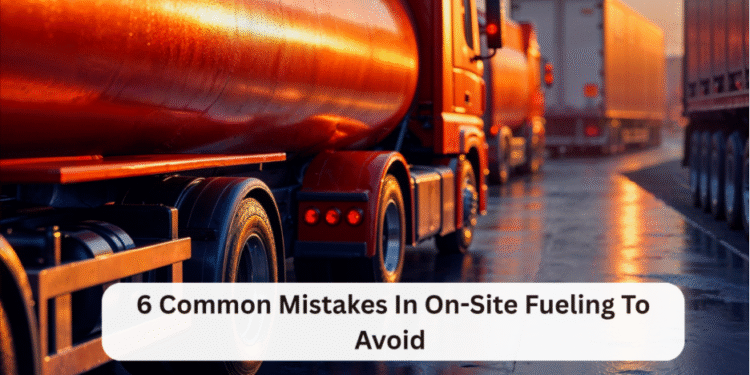On-site fueling has proved to be a game-changer for businesses that rely on their fleets of vehicles or heavy machinery. Nevertheless, there is more responsibility that comes with this convenience.
Moreover, the errors related to operational on-site fueling may have severe repercussions in the form of safety threats, environmental damage, unforeseen expenditures, and fines.
Numerous companies, whether newcomers to on-site fueling or established practitioners, make common mistakes that undermine operations and affect the bottom line. Even minor neglects, like skipped fuel quality checks or inappropriate adherence to the safety regulations, might become an expensive issue.
Therefore, it is necessary to avoid such mistakes to get the most out of on-site fueling.
Want to know more about these mistakes?
This article will discuss six common fueling pitfalls and the actions you can take to avoid them, ensuring safe, efficient, and compliant fueling processes.
1. Inadequate Fuel Storage and Containment
Poor storage of fuel is a costly mistake that can cause environmental penalties, lost fuel, and downtime. In this context, improper fuel storage in poorly maintained tanks without secondary containment or exposure to weather can result in leaks, contamination, or degradation of the fuel.
To prevent this, you should invest in certified on site fueling storage tanks with a containment system. They should also be environmentally compliant. Furthermore, storage units must have regular checks for corrosion, leakage, or structural collapse.
More importantly, ensure to protect the storage from sunlight, water invasion, and proper working of venting systems.
2. Ignores Safety Precautions
The worst mistake in on-site fueling is the failure to observe and follow correct safety measures. Fuel is hazardous, and improper handling leads to fires, environmental pollution, and severe injury.
Some of the common safety violations are:
- Fueling near sources of ignition
- Allowing untrained people to work with fuel dispensers
- Failure to follow spill containment measures
- Failing to apply the correct PPE (Personal Protective Equipment)
You can avoid this by implementing proper fueling safety measures, fully training all employees, and performing frequent safety checks. Also, have spill kits readily available and maintain proper signage and barricades while fueling.
3. Skipping Fuel Quality Control
Fuel contamination is a silent enemy that can damage your equipment. For example, water, contaminants, and microbial growth in fuel storage tanks can compromise fuel quality, harming engines, clogging filters, and decreasing fuel efficiency.
Speaking of which, most firms take fuel received on delivery as always clean and consumable without regular checks or filtration. However, you should not do this. Instead, you must have a proactive fuel quality plan.
This plan can include regular sampling for contaminants, adding filters at strategic dispensing locations, and tank cleaning for preventive maintenance. As a result, fuel quality monitoring keeps your equipment and fleet running at their best.
4. Inaccurate Fuel Tracking and Record-Keeping
Failure to monitor fuel consumption opens companies to fuel loss, misuse, and incorrect budgeting. For instance, random data entry, manual records, or no tracking are easy errors that compromise cost management and openness in on-site fueling operations.
To prevent it, implement digital fuel management systems that track real-time fuel deliveries, usage, and stock. This automated system prevents human error and offers detailed reports for audit trails, budgeting, and performance analysis.
Therefore, reliable fuel tracking not only avoids losses but also simplifies fuel tax reporting and compliance documentation.
5. Scheduling Fuel Deliveries Inefficiently
Fuel delivery logistics are mission-critical but frequently undervalued components of on-site fueling operations. Poor scheduling can lead to a variety of issues, including overstocking, emergency shortages, and avoidable costs due to last-minute or off-cycle deliveries.
Also, organizations that do not control fueling schedules in accordance with their operating requirements can experience unwarranted downtime, interfere with workflow, and pay premium delivery charges. In other words, when uncoordinated, the fueling function is reactive, inefficient, and expensive.
To avoid this, you can plan a formalized fuel delivery schedule that suits your site’s unique use patterns and operating schedules. You can also discuss with your fuel supplier to estimate levels of consumption and schedule deliveries in advance.
Moreover, use telemetry systems that track fuel levels in real time and automatically place reorders when stock falls below set levels. This scheduled planning keeps things moving without holding excess inventory or incurring unnecessary costs.
6. Disregarding Regulatory Compliance Requirements
Operations on site are also subject to strict federal, state, and local regulations about fuel storage, dispensing, job-related environmental protection, and on-site job safety. Non-compliance with these steps can subject businesses to severe penalties in the form of hefty fines, lawsuits, and possible closings.
In this context, a few common errors are improper registration of tanks, neglect of spill prevention measures, insufficient employee safety training, and failure to maintain inspection records.
To deal with this issue, you must be aware of the proper regulations, like the EPA’s Spill Prevention, Control and Countermeasure (SPCC), OSHA’s safety measures, and other regulations.
You can even partner with an experienced, compliance-conscious fuel supplier to minimize this burden of regulatory requirements. Also, conduct regular compliance audits, keep documentation of all relevant information, and ensure your staff is adequately trained in safety procedures.
Conclusion
On-site fueling can significantly enhance operational efficiency, reduce downtime, and offer cost advantages. However, overlooking safety, fuel quality, record-keeping, logistics, or regulatory compliance can negate these benefits.
Plus, it can expose your business to operational disruptions and financial risks. By understanding and avoiding these six common on-site fueling mistakes, you can ensure a safer, more reliable, and cost-effective fueling process.
Consequently, preventing these pitfalls not only protects your business but also strengthens your operational resilience, ensuring your fleet and equipment are always ready for action.













